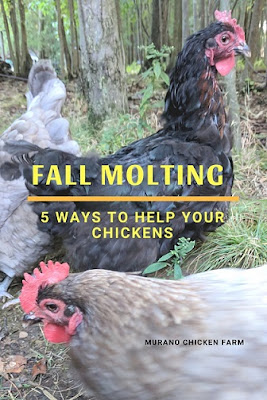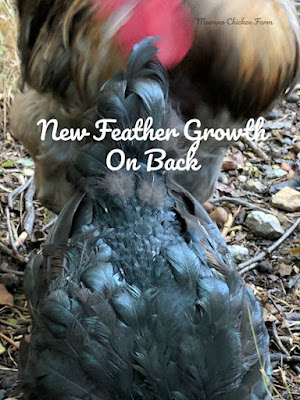The definition of molt is:
(of birds, insects, reptiles, etc.) to cast or shed the feathers, skin, or the like, that will be replaced by a new growth. dictionary.com
If that makes you think your chickens feathers are going to fall out, you're right.
Are your chickens molting?
Molting is a natural process of shedding and regrowing feathers. New feathers start to form pushing out old feathers. Molting feathers fall out in a pattern from head to tail.
I usually notice the loss of neck feathers first, followed closely by the body of the chicken then the wings and lastly the tail.
Molting can be mild or severe.
Some hens molt slowly, just losing a few feathers here and there over a longer period of time. Other chickens molt quickly, dropping lots of feathers suddenly. These are called 'soft' and 'hard' molts.
The black hen in the picture went through a hard molt and is starting to recover nicely. A hard molt can look like you're chicken has been plucked, but a soft molt can be barely noticeable.
Chickens usually have their first molt at 18 months then molt yearly after that. If you bought your chicks in the spring, their first molt would be in the following fall.
Hens stop laying eggs during molting as their body needs the nutrition and protein to put into new feather growth. Molting can take anywhere from 1-3 months.
Chicken usually molt at the end of summer or in autumn. Just like egg production, molting is triggered by shorter daylight hours not by cooler weather.
What are feathers made of?
Bird feathers are made from the protein Keratin.
Keratin is the protein that protects epithelial cells from damage or stress. ... It is also the key structural material making up the outer layer of human skin.
So bird feathers are made up of the same thing as we are! Pretty neat, right?
As you can imagine, if you had to suddenly replace a good amount of your skin, you would need some TLC and a serious nutritional boost to help support that! Chickens are no different.
They need increased nutrition to help them through their molt. Here are 5 ways you can help your chickens get through their fall molt.
How to care for molting chickens:
1) Increase protein levels
Some chicken keepers like to switch to a feed with more protein during the fall molt. I often add game bird feed to my chickens diet during this time.
It's not always feasible though, so try to supplement by feeding extra protein sources like scrambled eggs, BOSS or mealworms.
Allowing the flock to free range will also help their protein levels as they can eat lots of yummy bugs and the occasional lizard, frog or mouse. (yes, I know it's gross...no, you probably can't stop them from doing it)
2) Skip the snacks
We all want to give our flock treats but the low carb and high sugar treats are not a good choice during fall molting.
Bread, fruit, vegetables and other low protein foods should be fed at a minimum during this time. Instead you can give your chickens nuts, seeds like BOSS, mealworms, meat and yogurt which are all high protein treats.
3) Ferment some feed:
Fermented feed has tons of probiotics and fermentation makes the vitamins, minerals and proteins more bioavailable to them. Plus, fermented feed is easier for them to digest which is great during this stressful time.
Here's my easy method for fermenting feed. If you happen to make kombucha you can feed your chickens an extra scoby for a probiotic boost.
4) Don't touch!
Try not to pick your chickens up much during their molt. New feathers are full of blood when they grow in and will bleed like crazy if one breaks.
Plus, they're sensitive to the touch. Depending how severe their molt is, picking a chicken up can actually hurt her.
5) Consider the weather.
In very cold climates or if a hen happens to have a late molt she might be cold.
If it's cold enough to snow and your chicken is still a bit naked consider putting a chicken saddle on her for warmth or adding a heat light to the coop. Make sure any heat lamp is double or triple secured though!
Without feathers a chicken has a hard time regulating their body heat. Occasionally chickens will molt in winter and might need a little help staying warm.
Bonus: Check for mites and lice and treat by dusting with DE if parasites are found. Being bug free will make their molt recovery much easier!
Remember that no matter how scraggly they look, molting is a natural part of life for chickens and they will come through it just fine. They will appreciate the treats and TLC though!
~L
Want information on raising chickens sent right to your email weekly? Click right here to join my list and get new posts sent directly to you the day they're published. You'll also get the free download 25 Ways to save money raising chickens.
I am not a veterinarian or other animal care professional nor do I claim to be. I am simply passing on information that has worked for me and my flock. This information is for entertainment purposes only and is not meant to treat or diagnose any medical condition. Please see a vet if your chicken is ill. Click for my full disclaimer.
This post contains affiliate links. If you chose to purchase something through the link, I will get a small payment from Amazon. It will not affect your purchase price. Click for full disclosure.





Thank you for the information. We always feel sorry for the girls when they start their molt, the bantams look small and straggly more than the big girls. Will have a go at the fermentation idea, we usually chuck the old pellets to the wild birds. Mike UK.
ReplyDeleteYW! I feel so sorry for them too! They look all scraggly and sad. This year my rooster lost his tail feathers and he looks ridiculous! lol Try the fermentation, I think you'll be happy with it!
Delete~Lisa
Thank you for sharing this with us on the Homestead Blog Hop! :)
ReplyDeleteThank you for the information. One of my white chickens has been molting for a long while now. She lost almost everything. She is looking better now but her comb looks awful, all the others are fine. Any suggestions
ReplyDeleteAwww, poor girl! Make sure your hen doesn't have mites or lice (which are often brought around by wild birds) they can often cause pale combs in chickens. Give her treats high in protein like mealworms and BOSS to help her recovery. She might just need a little extra TLC since her molt was so hard on her! I hope she feels better soon!
DeleteLisa
I am new to chicken raising. What is BOSS??
ReplyDeleteHi Donna,
DeleteIt is Black Oil Sunflower Seeds. They are high in protein and fat which is great for helping the chickens to regrow new feathers!
Lisa
Black soldier fly grubs. There are a few suppliers. My flock runs toward me whenever I walk toward the feed bin for a handful, and I think everyone went through a molt, but I hardly noticed any difference?
ReplyDelete